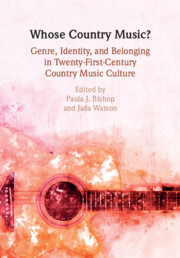Book contents
- Whose Country Music?
- Whose Country Music?
- Copyright page
- Contents
- Figures
- Tables
- Contributors
- “She went to Nashville to sing country music”
- Part I Industry
- Part II Codes of Conduct
- Part III Authenticity
- Part IV Boundary Work
- 13 Playing at the Border
- 14 Country-Loving Mexican Americans
- 15 Practices of Genre Surveillance in Country Music
- 16 “We Have a Lot of Work To Do”
- Epilogue
- Bibliography
- Index
13 - Playing at the Border
Navajo (Diné) Country Music and Border Town Racism
from Part IV - Boundary Work
Published online by Cambridge University Press: 03 February 2023
- Whose Country Music?
- Whose Country Music?
- Copyright page
- Contents
- Figures
- Tables
- Contributors
- “She went to Nashville to sing country music”
- Part I Industry
- Part II Codes of Conduct
- Part III Authenticity
- Part IV Boundary Work
- 13 Playing at the Border
- 14 Country-Loving Mexican Americans
- 15 Practices of Genre Surveillance in Country Music
- 16 “We Have a Lot of Work To Do”
- Epilogue
- Bibliography
- Index
Summary
Drawing on two and a half years of ethnographic fieldwork singing and playing with three Diné country-western bands, I explore how one Native band lives and responds to border town racism and settler nativism in towns bordering the Navajo Nation, the largest Indian reservation in the United States. I illustrate how country music, a genre that has been embraced by Diné people since the late 1930s, serves as a flashpoint for racialized forms of difference and belonging within the liminal space of the Navajo reservation “border town.” I argue that country music performance serves as a condensed site for the enactment and negotiation of border town tensions, microaggressions, and more blatant forms of racism, providing key insights into the ways in which Indigenous country music unsettles Colorado’s own settler-colonial and settler nativist histories in the border town Southwest.
Keywords
- Type
- Chapter
- Information
- Whose Country Music?Genre, Identity, and Belonging in Twenty-First-Century Country Music Culture, pp. 193 - 209Publisher: Cambridge University PressPrint publication year: 2022

